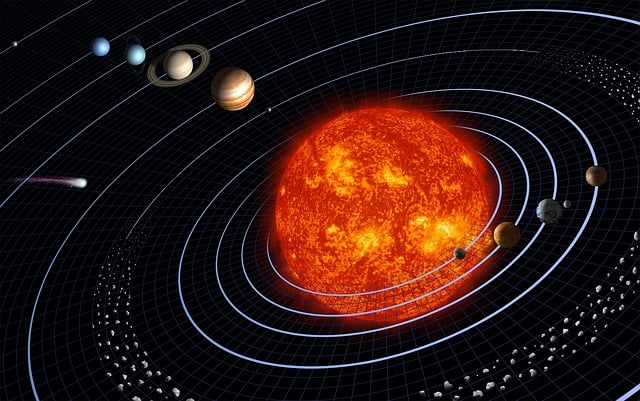The Sun is the star at the center of our Solar System and is a massive ball of hot plasma. It is a main-sequence star and is considered to be an average star, with an average size and temperature compared to other stars. The Sun is approximately 4.6 billion years old and has a total life span of around 10 billion years.
The Sun is the source of light and heat for the Earth and other planets in the Solar System. It is also the source of energy for all life on Earth, as photosynthesis in plants converts sunlight into energy.
The Sun’s outer layer is called the corona and it is much hotter than the Sun’s surface, reaching temperatures of millions of degrees. The corona is visible during a solar eclipse and is thought to be heated by magnetic waves and interactions with the Sun.
The Sun also experiences regular solar activity, such as sunspots, solar flares, and coronal mass ejections. These events can have an impact on communication systems on Earth and can also cause auroras.
The Sun appears bright because it is a star that produces its own light and heat. It is made up of hot plasma, and the energy it releases through nuclear fusion reactions is what makes it shine. Additionally, the Sun is relatively close to Earth compared to other stars, which also contributes to its brightness.
What is sun doesn’t exist? How important is sun for earth?
The Sun is extremely important for life on Earth and its existence has a profound impact on our planet. Some of the key ways in which the Sun impacts Earth include:
- Energy source: The Sun is the primary source of energy for all life on Earth. It provides the energy necessary for photosynthesis in plants, which produces the oxygen that all living things need to survive.
- Climate regulation: The Sun’s energy drives Earth’s climate and weather patterns. It heats the atmosphere, drives ocean currents, and affects wind patterns.
- Protection: The Sun’s strong solar wind protects the Earth from harmful particles and radiation from space, ensuring that life on Earth is not affected by this dangerous material.
- Gravity: The Sun’s gravity keeps the Earth and other planets in their orbits, ensuring the stability of our Solar System.
The Sun can be both a protector and a potential killer for Earth. On one hand, the Sun provides the energy and warmth necessary for life on Earth and protects the planet from harmful particles and radiation from space. On the other hand, if the Sun’s energy were to increase too much, it could cause devastating effects on Earth, such as heat waves, droughts, and increased solar activity like solar flares and coronal mass ejections, which could disrupt communication systems on Earth.
Therefore, while the Sun is essential for life on Earth, it is also a powerful force that can have both positive and negative effects on our planet. It is important to continue studying the Sun and its behaviour in order to understand more about its impact on Earth and to be prepared for any potential hazards.
Will sun explode and become blackhole?
The Sun will not become a black hole. Black holes are formed from the collapse of massive stars, which are much larger than the Sun. The Sun is a main-sequence star, and when it reaches the end of its life cycle, it will undergo a process known as a “giant phase” where it will expand into a red giant and eventually shed its outer layers, leaving behind a white dwarf.
It is important to note that the Sun’s future evolution will have a profound impact on the Solar System, and it is likely that the Earth will no longer be able to sustain life once the Sun enters its red giant phase. However, the Sun will not become a black hole.
Sun will not explode as a supernova. Supernovae occur when a massive star runs out of fuel and collapses, causing a massive explosion that can outshine an entire galaxy. The Sun is not massive enough to undergo a supernova and instead will undergo a gentler process known as a “giant phase,” where it will expand into a red giant and eventually shed its outer layers, leaving behind a white dwarf.
What if sun was not there in solar system?
If the Sun were not there in the Solar System, the effects would be catastrophic and life as we know it would not exist. Some of the key ways in which the absence of the Sun would impact the Solar System include:
- No life: The Sun provides the energy necessary for photosynthesis in plants, which produces the oxygen that all living things need to survive. Without the Sun, life on Earth would not be possible.
- Cold temperatures: The Sun provides warmth and heat to the Solar System, and without it, temperatures would plummet and the entire Solar System would be cold and inhospitable.
- No light: The Sun provides the light that allows us to see during the day, and without it, there would be no day and night cycle.
- Instability: The Sun’s gravity helps to keep the planets in their orbits, ensuring the stability of the Solar System. Without the Sun, the planets would be affected by the gravitational forces of other nearby stars, and their orbits could become unstable.
What is summar solstice and winter solstice?
The Summer Solstice and Winter Solstice are two important astronomical events that occur each year and mark the changing of the seasons.
The Summer Solstice is the longest day of the year and occurs when the tilt of the Earth’s axis is at its maximum toward the Sun. This event typically occurs around June 20th or 21st and marks the start of summer in the Northern Hemisphere and winter in the Southern Hemisphere. During the Summer Solstice, the Sun rises early and sets late, providing the longest period of daylight of the year.
The Winter Solstice, on the other hand, is the shortest day of the year and occurs when the tilt of the Earth’s axis is at its maximum away from the Sun. This event typically occurs around December 20th or 21st and marks the start of winter in the Northern Hemisphere and summer in the Southern Hemisphere. During the Winter Solstice, the Sun rises late and sets early, providing the shortest period of daylight of the year.
Both the Summer and Winter Solstices have been celebrated for thousands of years by many cultures, who saw these events as a time to come together and celebrate the changing of the seasons. Even today, many people continue to mark these events with special ceremonies and celebrations. The Summer Solstice is generally considered better for crops and life than the Winter Solstice. During the Summer Solstice, the tilt of the Earth’s axis towards the Sun results in longer days, which means more sunlight and warmth for crops to grow. This increased sunlight and warmth also supports increased photosynthesis and helps to support a greater diversity of plant and animal life.
On the other hand, the Winter Solstice marks the beginning of winter, a time when temperatures are colder and daylight is shorter. This can be challenging for crops and other forms of life, as there is less sunlight and warmth available for growth. However, some plants and animals are able to adapt to these conditions and continue to thrive during the winter months.

What is the life of sun?
The Sun has a life span of approximately 10 billion years. It is currently in the middle of its life cycle and has about 5 billion years left. At the end of its life cycle, the Sun will become a red giant and eventually collapse into a white dwarf. The exact timeline of events that will occur during this process is still not well understood, but it is estimated to take several hundred million years.
Once the Sun exhausts its life span, it will undergo several changes. It will first expand into a red giant and eventually swallow up Mercury and Venus. Then, the outer layers of the Sun will be expelled into space, forming a planetary nebula. The core of the Sun will then collapse into a white dwarf, which will gradually cool over billions of years.
The fate of the solar system after the Sun’s death will depend on the orbits of the remaining planets. They may continue to orbit the white dwarf or be ejected from the solar system. The exact outcome is not yet known, but the death of the Sun will have significant consequences for the rest of the solar system.
The fate of the other planets in the solar system after the Sun exhausts its life span will depend on their orbits and gravitational interactions. Some planets may continue to orbit the white dwarf that remains after the Sun has died, while others may be ejected from the solar system. It’s also possible that the inner planets, such as Mercury and Venus, may be destroyed during the red giant phase as the Sun expands.
However, the exact outcome is uncertain and currently not well understood. The future of the solar system after the Sun’s death will be shaped by a complex set of physical and gravitational processes, which are still not fully understood.
Solar eclipse
During a solar eclipse, the Moon passes between the Sun and the Earth, blocking out the Sun’s light and casting a shadow on the Earth’s surface. This results in a partial or total eclipse, depending on the relative positions of the Sun, Moon, and Earth.
In a total eclipse, the Moon’s shadow covers the entire face of the Sun, creating a path of total darkness on the Earth’s surface. This typically lasts for a few minutes and can only be seen from a small area on the Earth’s surface.
In a partial eclipse, only a portion of the Sun’s light is blocked, and the Sun appears as a crescent on the Earth’s surface.
Solar eclipses are rare events and can have significant effects on the local environment, including changes in temperature and light levels. They are also important events for astronomers, who use eclipses to study the Sun’s corona and other features that are not normally visible.
Also, the Sun has an effect on tides like moon, but its influence is weaker than the Moon. Tides are caused by the gravitational attraction between two celestial bodies, such as the Earth and the Moon or the Earth and the Sun.
The Moon’s gravity is stronger than the Sun’s gravity, so it has a larger effect on the tides. When the Moon is closest to the Earth (i.e., at its perigee), its gravitational pull is stronger, resulting in higher tides. On the other hand, when the Moon is farthest from the Earth (i.e., at its apogee), its gravitational pull is weaker, resulting in lower tides.
The Sun also has a gravitational effect on tides, The Sun’s effect on tides is greatest when the Sun, Moon, and Earth are aligned, as during a new or full moon. At these times, the combined gravitational pull of the Sun and the Moon creates what are known as spring tides, which are higher tides than normal.

Red giant phase, the death of sun.
The red giant phase is a stage in the life cycle of a star like the Sun. It occurs when the star has exhausted the hydrogen fuel in its core and starts to burn helium instead. This causes the star to expand and its outer layers to cool and become red, hence the name “red giant”.
During the red giant phase, the star can grow to be many times larger than its original size, and it may also shed its outer layers into space. The exact timeline of events during the red giant phase is still not well understood, but it is estimated to take several hundred million years.
The red giant phase is a transitional stage in the life of a star, and it is followed by the eventual collapse of the star’s core into a white dwarf.
Astronomers have observed red giants in other galaxies. By studying these stars, they can gain insight into the processes that occur during the red giant phase and learn more about the life cycles of stars in general.
Observing red giants in other galaxies can also provide information about the evolution of galaxies and the universe as a whole. For example, by studying the distribution and abundance of red giants in a galaxy, astronomers can learn about the history of star formation and the age of the galaxy.
Other sun in milkyway galaxy.
It is estimated that there are hundreds of billions of stars in a typical galaxy, including many that are similar in size and luminosity to the Sun.
In our own Milky Way galaxy, there are an estimated 100-400 billion stars, with a significant fraction of these being stars similar to the Sun. However, it is difficult to accurately determine the exact number of stars in a galaxy, as many of them are too distant or obscured by dust to be observed directly.
In other galaxies, the number of stars can range from a few billion to several trillion, depending on the size and age of the galaxy. Studying the stars in different galaxies can provide valuable information about the evolution of the universe and the processes that govern the formation and evolution of stars.
And Yes, many other solar systems have been observed within our Milky Way galaxy. The discovery of exoplanets, or planets outside our solar system, has revolutionized our understanding of the universe and shown that planetary systems are common throughout the galaxy.
As of January 2023, over 4,000 exoplanets have been confirmed, with many more candidates still being studied. Some of these exoplanetary systems are similar in size and composition to our own solar system, while others are much different and contain giant planets in close orbit around their star.
The study of exoplanetary systems provides important insights into the formation and evolution of planetary systems and helps us understand the diversity of worlds that exist in the galaxy. These discoveries also raise the possibility of finding other solar systems with conditions that are suitable for life.
Finally, few takeaways…
The Sun is a star in our solar system and is the closest star to Earth. It provides light and heat to the planets in the solar system and is in the main sequence phase of its life, where it is actively burning hydrogen to produce energy. The fate of the Sun and the other planets in the solar system after the Sun exhausts its life span is not well understood, but it is estimated that the Sun will eventually become a red giant and then collapse into a white dwarf.
In addition to our own solar system, many other solar systems have been observed in our Milky Way galaxy, including over 4,000 confirmed exoplanets. The study of exoplanetary systems and other stars provides important insights into the formation and evolution of planetary systems and helps us understand the diversity of worlds that exist in the galaxy.
